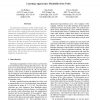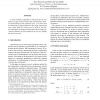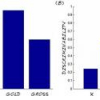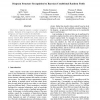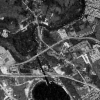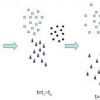CVPR
2005
IEEE
15 years 3 months ago
2005
IEEE
Over the last couple of years, face recognition researchers have been developing new techniques. These developments are being fueled by advances in computer vision techniques, com...
CVPR
2005
IEEE
15 years 3 months ago
2005
IEEE
We consider the problem of calibrating a highly generic imaging model, that consists of a non-parametric association of a projection ray in 3D to every pixel in an image. Previous...
CVPR
2005
IEEE
15 years 3 months ago
2005
IEEE
The appearance of dynamic scenes is often largely governed by a latent low-dimensional dynamic process. We show how to learn a mapping from video frames to this lowdimensional rep...
CVPR
2005
IEEE
15 years 3 months ago
2005
IEEE
Reliable detection of human activity is an unsolved problem. The main is that low resolution and the unconstrained nature of realistic environments and human behaviourmakeform cue...
CVPR
2005
IEEE
15 years 3 months ago
2005
IEEE
A novel, nonlinear algorithm is introduced for the estimation of rigid camera motion from instantaneous velocity measurements in the calibrated case. It is shown that by minimizin...
CVPR
2005
IEEE
15 years 3 months ago
2005
IEEE
A major goal for face recognition is to identify faces where the pose of the probe is different from the stored face. Typical feature vectors vary more with pose than with identit...
CVPR
2005
IEEE
15 years 3 months ago
2005
IEEE
Hand-drawn diagrams present a complex recognition problem. Elements of the diagram are often individually ambiguous, and require context to be interpreted. We present a recognitio...
CVPR
2005
IEEE
15 years 3 months ago
2005
IEEE
Scale-spaces induced by diffusion processes play an important role in many computer vision tasks. Automatically selecting the most appropriate scale for a particular problem is a ...
CVPR
2005
IEEE
15 years 3 months ago
2005
IEEE
CVPR
2005
IEEE
15 years 3 months ago
2005
IEEE
One of the classic problems in low level vision is image restoration. An important contribution toward this effort has been the development of shock filters by Osher and Rudin [1]...

